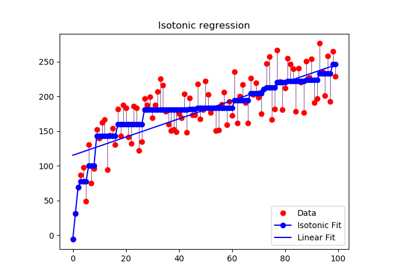sklearn.isotonic.IsotonicRegression¶
-
class
sklearn.isotonic.IsotonicRegression(y_min=None, y_max=None, increasing=True, out_of_bounds='nan')[source]¶ Isotonic regression model.
The isotonic regression optimization problem is defined by:
min sum w_i (y[i] - y_[i]) ** 2 subject to y_[i] <= y_[j] whenever X[i] <= X[j] and min(y_) = y_min, max(y_) = y_max
- where:
y[i]are inputs (real numbers)y_[i]are fittedXspecifies the order. IfXis non-decreasing theny_is non-decreasing.w[i]are optional strictly positive weights (default to 1.0)
Read more in the User Guide.
New in version 0.13.
- Parameters
- y_minoptional, default: None
If not None, set the lowest value of the fit to y_min.
- y_maxoptional, default: None
If not None, set the highest value of the fit to y_max.
- increasingboolean or string, optional, default: True
If boolean, whether or not to fit the isotonic regression with y increasing or decreasing.
The string value “auto” determines whether y should increase or decrease based on the Spearman correlation estimate’s sign.
- out_of_boundsstring, optional, default: “nan”
The
out_of_boundsparameter handles how x-values outside of the training domain are handled. When set to “nan”, predicted y-values will be NaN. When set to “clip”, predicted y-values will be set to the value corresponding to the nearest train interval endpoint. When set to “raise”, allowinterp1dto throw ValueError.
- Attributes
- X_min_float
Minimum value of input array
X_for left bound.- X_max_float
Maximum value of input array
X_for right bound.- f_function
The stepwise interpolating function that covers the input domain
X.
Notes
Ties are broken using the secondary method from Leeuw, 1977.
References
Isotonic Median Regression: A Linear Programming Approach Nilotpal Chakravarti Mathematics of Operations Research Vol. 14, No. 2 (May, 1989), pp. 303-308
Isotone Optimization in R : Pool-Adjacent-Violators Algorithm (PAVA) and Active Set Methods Leeuw, Hornik, Mair Journal of Statistical Software 2009
Correctness of Kruskal’s algorithms for monotone regression with ties Leeuw, Psychometrica, 1977
Examples
>>> from sklearn.datasets import make_regression >>> from sklearn.isotonic import IsotonicRegression >>> X, y = make_regression(n_samples=10, n_features=1, random_state=41) >>> iso_reg = IsotonicRegression().fit(X.flatten(), y) >>> iso_reg.predict([.1, .2]) array([1.8628..., 3.7256...])
Methods
fit(self, X, y[, sample_weight])Fit the model using X, y as training data.
fit_transform(self, X[, y])Fit to data, then transform it.
get_params(self[, deep])Get parameters for this estimator.
predict(self, T)Predict new data by linear interpolation.
score(self, X, y[, sample_weight])Return the coefficient of determination R^2 of the prediction.
set_params(self, \*\*params)Set the parameters of this estimator.
transform(self, T)Transform new data by linear interpolation
-
__init__(self, y_min=None, y_max=None, increasing=True, out_of_bounds='nan')[source]¶ Initialize self. See help(type(self)) for accurate signature.
-
fit(self, X, y, sample_weight=None)[source]¶ Fit the model using X, y as training data.
- Parameters
- Xarray-like of shape (n_samples,)
Training data.
- yarray-like of shape (n_samples,)
Training target.
- sample_weightarray-like of shape (n_samples,), default=None
Weights. If set to None, all weights will be set to 1 (equal weights).
- Returns
- selfobject
Returns an instance of self.
Notes
X is stored for future use, as
transformneeds X to interpolate new input data.
-
fit_transform(self, X, y=None, **fit_params)[source]¶ Fit to data, then transform it.
Fits transformer to X and y with optional parameters fit_params and returns a transformed version of X.
- Parameters
- Xnumpy array of shape [n_samples, n_features]
Training set.
- ynumpy array of shape [n_samples]
Target values.
- **fit_paramsdict
Additional fit parameters.
- Returns
- X_newnumpy array of shape [n_samples, n_features_new]
Transformed array.
-
get_params(self, deep=True)[source]¶ Get parameters for this estimator.
- Parameters
- deepbool, default=True
If True, will return the parameters for this estimator and contained subobjects that are estimators.
- Returns
- paramsmapping of string to any
Parameter names mapped to their values.
-
predict(self, T)[source]¶ Predict new data by linear interpolation.
- Parameters
- Tarray-like of shape (n_samples,)
Data to transform.
- Returns
- T_array, shape=(n_samples,)
Transformed data.
-
score(self, X, y, sample_weight=None)[source]¶ Return the coefficient of determination R^2 of the prediction.
The coefficient R^2 is defined as (1 - u/v), where u is the residual sum of squares ((y_true - y_pred) ** 2).sum() and v is the total sum of squares ((y_true - y_true.mean()) ** 2).sum(). The best possible score is 1.0 and it can be negative (because the model can be arbitrarily worse). A constant model that always predicts the expected value of y, disregarding the input features, would get a R^2 score of 0.0.
- Parameters
- Xarray-like of shape (n_samples, n_features)
Test samples. For some estimators this may be a precomputed kernel matrix or a list of generic objects instead, shape = (n_samples, n_samples_fitted), where n_samples_fitted is the number of samples used in the fitting for the estimator.
- yarray-like of shape (n_samples,) or (n_samples, n_outputs)
True values for X.
- sample_weightarray-like of shape (n_samples,), default=None
Sample weights.
- Returns
- scorefloat
R^2 of self.predict(X) wrt. y.
Notes
The R2 score used when calling
scoreon a regressor will usemultioutput='uniform_average'from version 0.23 to keep consistent withr2_score. This will influence thescoremethod of all the multioutput regressors (except forMultiOutputRegressor). To specify the default value manually and avoid the warning, please either callr2_scoredirectly or make a custom scorer withmake_scorer(the built-in scorer'r2'usesmultioutput='uniform_average').
-
set_params(self, **params)[source]¶ Set the parameters of this estimator.
The method works on simple estimators as well as on nested objects (such as pipelines). The latter have parameters of the form
<component>__<parameter>so that it’s possible to update each component of a nested object.- Parameters
- **paramsdict
Estimator parameters.
- Returns
- selfobject
Estimator instance.

